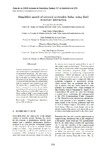Mostrar o rexistro simple do ítem
Simplified model of ureteral peristalsis bolus using fluid structure interaction
| dc.contributor.author | Mancha Sánchez, Enrique | |
| dc.contributor.author | Gómez Blanco, Juan Carlos | |
| dc.contributor.author | De la Cruz Conty, Julia Estíbaliz | |
| dc.contributor.author | Sánchez Margallo, Francisco Miguel | |
| dc.contributor.author | Pagador Carrasco, José Blas | |
| dc.contributor.author | Soria Gálvez, Federico | |
| dc.date.accessioned | 2020-02-21T10:54:04Z | |
| dc.date.available | 2020-02-21T10:54:04Z | |
| dc.date.issued | 2018 | |
| dc.identifier.citation | Mancha Sánchez, E., Gómez Blanco, J.C., de la Cruz Conty, J.E., Sánchez Margallo, F.M., Pagador Carrasco, J.B., Soria Gálvez, F. Simplified model of ureteral peristalsis bolus using fluid structure interaction. En Actas de las XXXIX Jornadas de Automática, Badajoz, 5-7 de Septiembre de 2018 (pp.731-736). DOI capítulo: https://doi.org/10.17979/spudc.9788497497565.0731 DOI libro: https://doi.org/10.17979/spudc.9788497497565 | es_ES |
| dc.identifier.isbn | 978-84-09-04460-3 (UEX) | |
| dc.identifier.isbn | 978-84-9749-756-5 (UDC electrónico) | |
| dc.identifier.uri | http://hdl.handle.net/2183/24986 | |
| dc.description.abstract | [Abstract] Current computational models of ureter are not usually based on physiological behavior of anatomical structures. For this reason, we propose a new simplified model of ureteral flow to simulate a peristalsis bolus on the distal section of the ureter. This model uses a closed ureter that generates the urinary bolus with an expansive force applied in its wall. To analyse this, a computational FSI simulation is proposed to recreate the peristalsis movement of the ureter in its distal section. These preliminary results will be improved in future works to build a more complex model and to analyse the effects in the urine flow of a new design of a half-length ureteral stent. | es_ES |
| dc.description.abstract | [Resumen] Los modelos computacionales actuales de uréter no suelen basarse en el comportamiento fisiológico de las estructuras anatómicas. Por este motivo, proponemos un nuevo modelo simplificado de flujo ureteral para simular un bolo de peristalsis en la sección distal del uréter. Este modelo utiliza un uréter cerrado que genera el bolo urinario con una fuerza expansiva aplicada en su pared. Para analizar esto, se propone una simulación computacional del FSI para recrear el movimiento peristáltico del uréter en su sección distal. Estos resultados preliminares se mejorarán en trabajos futuros para construir un modelo más complejo y analizar los efectos en el flujo de orina de un nuevo diseño de un stent ureteral de longitud media. | es_ES |
| dc.description.sponsorship | Ministerio de Economía y Competitividad; PI16/01707 | es_ES |
| dc.language.iso | eng | es_ES |
| dc.publisher | Área de Ingeniería de Sistemas y Automática, Universidad de Extremadura | es_ES |
| dc.relation.hasversion | http://hdl.handle.net/10662/8630 | |
| dc.relation.uri | https://doi.org/10.17979/spudc.9788497497565.0731 | es_ES |
| dc.rights | Atribución-NoComercial 3.0 España | es_ES |
| dc.rights.uri | http://creativecommons.org/licenses/by-nc/3.0/es/ | * |
| dc.subject | Computational simulation | es_ES |
| dc.subject | Ureter | es_ES |
| dc.subject | FSI | es_ES |
| dc.subject | Peristalsis | es_ES |
| dc.title | Simplified model of ureteral peristalsis bolus using fluid structure interaction | es_ES |
| dc.type | info:eu-repo/semantics/conferenceObject | es_ES |
| dc.rights.access | info:eu-repo/semantics/openAccess | es_ES |
| UDC.startPage | 731 | es_ES |
| UDC.endPage | 736 | es_ES |
| dc.identifier.doi | https://doi.org/10.17979/spudc.9788497497565.0731 | |
| UDC.conferenceTitle | XXXIX Jornadas de Automática | es_ES |






